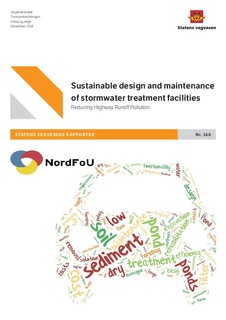| dc.description.abstract | Highway runoff contains a complex mixture of contaminants that may cause negative effects in natural water systems. European national road administrations follow local management practices in order to reduce runoff impact to a minimum. This report makes a cross- comparison of current practices regarding stormwater treatment in five European countries: Sweden, Norway, Germany, Austria, and Switzerland. The goal of this report is to identify the current practices concerning stormwater treatment and sediment handling, and determine sustainable ways to design future stormwater treatment facilities.
Current legislations, treatment technologies and best management practice (BMP) are discussed. The data were collected by means of review of relevant documents and literature regarding legislation and practices from each country, and interviews with professionals and experts in stormwater treatment.
The report concludes that the current Norwegian and German guidelines and regulations regarding handling of stormwater sediments are synchronized and up to date. Sweden’s guidelines are, however, outdated, and present challenges that may lead to technical issues. Three main alternatives for future handling of stormwater sediments are suggested:
1) Alternative handling of sediment from retention ponds. Rehabilitation plans should include cost analysis when planning and constructing stormwater treatment facilities. Sediments should be handled as dry as possible. Rehabilitation of old ponds should include installation of a forebay.
2) Development and introduction of alternative techniques, such as the implementation of infiltration facilities combined with a forebay.
3) Recommendations, techniques and management remain unchanged, with ponds as the preferred solution, but with the development of a more comprehensive written “how-to” guide.
The report recommends updating the Swedish guidelines for when treatment is necessary by combining the Norwegian and German decision charts; with an ADT below 3000, or between 3000-30000 in areas with documented low vulnerability, local stormwater infiltration into embankments, road shoulders or ditches is recommended if the substrate porosity is sufficient. For areas with medium vulnerability, infiltration is possible depending on substrate permeability when pollutant load and negative impact on receiving waterbodies are considered low. In highly vulnerable zones, where negative impact on receiving waters is anticipated, treatment in a retention facility is needed before water can be discharged. Stormwater should be collected to a retention facility and treated before discharge to the receiving water when ADT is above 30000. The same applies for roads with stormwater grids and also for tunnels.
Infiltration basins combined with a forebay are widely applied in Austria and Germany, and are potentially good solutions for future treatment facilities in Nordic countries. They are more cost effective, improve the quality of the discharged water and provide better retention in comparison to ponds. Further knowledge regarding their functionality in cold climates is, however, required. When retention ponds are the choice, handling sediment adequately is crucial. Sediments must be as dry as possible prior handling. On-site drying process should always be considered before transporting the sediment to landfills. This is achieved by stormwater bypass or re-direction during the handling process, and exposure to natural drying processes before further treatment by repeated freeze and thaw cycles.
Appendix B1 presents a detailed analysis of the strengths, weaknesses, opportunities and threats (SWOT) regarding the possible treatment solutions. | nb_NO |

